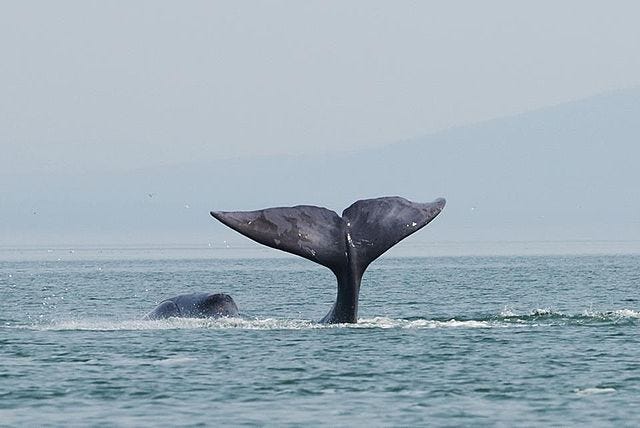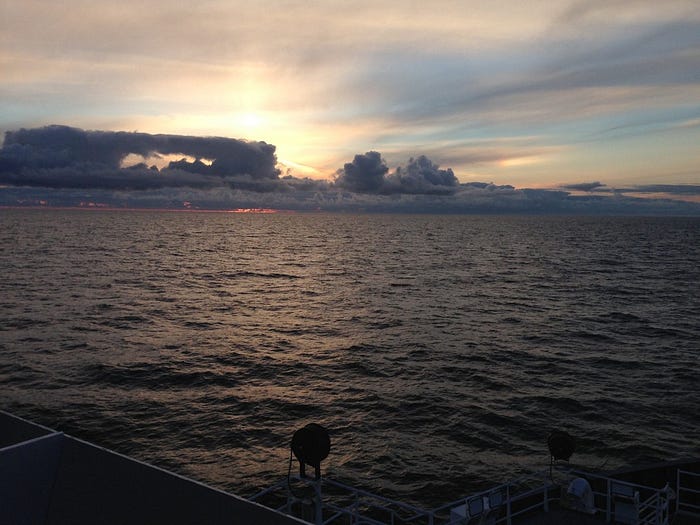Whale speak: Why does a humpback slap its tail?
Emily Boring | Nov. 30, 2015

Ship Log: NOAA R.V. Bell Shimada
May 30, 2015, 8:50 pm
Week two aboard the NOAA R.V. Bell Shimada, 60 kilometers off the coast of Bandon, Oregon. I haven’t seen land in ten days. Between sea, sky, fog, and drizzle, I’ve learned about fifty new ways to describe the color “gray.” It’s twilight. A long day of observation, and the night-shift fishing trawls start any minute. But for a rare moment, all thirteen scientists, the crew, and I gather in silence on the upper-most deck, the Flying Bridge. We face the horizon, watching.
Framed against the orange sun is a single whale. Humpback. Huge. We’ve seen over thirty today, but this one is unique. This whale is slapping its tail. The tail arches up and down, curved like a haunting bow, whisking milky spume from dark ocean. Slap, splash! it pounds, over and over, in hypnotizing rhythm. We watch until long after sunset. No one moves. No one speaks. The whale never stops. The tail is still slapping as the humpback slides through fingers of fog, into darkness, and out of sight.
I wrote these words on a two-week research voyage with the National Oceanic and Atmospheric Association last June. I joined a team of scientists from Oregon’s Hatfield Marine Science Center on an expedition to study juvenile rockfish, water quality, and general ecosystem stability off the Pacific Coast. Many memorable experiences stand out from my time at sea. Among the mundane, I learned the value of seasickness medication and the difficulty of taking a shower on a boat rocking in 20-foot swells. Among the more profound, I learned new definitions for wonder, awe, and observation. I felt the insignificance of watching millions of gallons of water and thousands of miles of empty sky during 13-hour bird-watching shifts. I discovered the thrill of pulling up nets of nighttime creatures — fluorescing, throbbing, translucent life-forms from the deep — for which science doesn’t yet have a name.
But of all my experiences on the R.V. Bell Shimada, one image stands out above the rest: the humpback whale slapping its tail. For weeks afterward, I’d close my eyes and see the arc of a whale’s tail burned into an orange sunset. The image brings up immediate scientific queries: Why do humpbacks slap their tails? What, if anything, are they trying to do or say?

The view from the NOAA R.V. Bell Shimada. (Photo by Emily Boring.)
But my experience of the tail-slap calls for something beyond mere scientific explanation. Something about the action was powerful enough to arrest twelve scientists in silent awe. Later, we’d try to describe the emotions we felt the whale was expressing. We’d throw out words like desperation, persistence, joy, kinship, connection, pain… No one could quite describe it, but all of us felt the captivation. And it’s this shared wonder, just as much as the whale’s behavior, that continues to fascinate me. Why were we so drawn to the whale’s tail? Are there lessons there about the line between science and emotion, between humans and nature, and about the ecosystems we share?
A first attempt at explanation for a slapping humpback is simple: tail-slapping might merely be a feeding technique. The behavior is officially called “lob-tailing.” In studies of humpback whales off the coast of Maine, lob-tailing is often coupled with another feeding technique called “bubble-net feeding.” The whale slaps its tail to scare fish away from the surface. Then it descends, blows a giant bubble to corral the fish into dense schools, and lunges up with its jaws open wide. The lob-tailing step is critical to keep prey from jumping out of the water away from the whale. Lob-tailing is particularly effective for capturing sand-lance, a type of fish whose population swelled in response to the collapse of Atlantic herring stocks. This explanation, though it paints lob-tailing as an innovative adaptation to take advantage of new prey, nevertheless suggests its function is no more than basic nutritional need.
Twenty minutes of watching the power and persistence of a tail-slap, however, left me skeptical that lob-tailing is just a feeding technique. Our overwhelming question was not, “What is that whale eating?” but “What is it trying to say?” Sure enough, evidence suggests that tail-slapping may be a form of social communication. According to studies of sperm whales, lob-tailing is a key coordinator of group and unit dynamics in whale communities. It may signal things like, “Please leave!”, “May I join?”, or “Let’s get going!” This explanation elevates lob-tailing to more than a basic tool for food. Instead, many scientists take the slap as evidence of the complex social dynamics in whale communities.
Yet the idea of lob-tailing as a form of communication raises a large problem: energetically speaking, it is extremely expensive. Any action that propels part of a whale out of the water — like breaching, fin-slapping or lob-tailing — takes as much as .075% of a whale’s daily metabolic activity per slap. Multiply that by twenty straight minutes of slapping at thirty slaps per minute, and that’s a lot of energy. Is lob-tailing worth it? Whales certainly have plenty of lower-cost ways to get a message across. Vocal signals produce sounds of much larger amplitude and use less energy than tail slaps. In a cost-benefit analysis, lob-tailing doesn’t add up. And yet the whale still slaps.
This dilemma, which has perplexed scientists for years, pulled on my mind as I watched the tail from the top deck. Beyond immediate beauty and captivation, I glimpsed the unseen cycles of cost and benefit, of give and take, that underlie the biology and chemistry of the natural world. In each slap, I sensed the whole chain of reactions and processes that led to it. First, the far-off fission of sun fuels the metabolism of zooplankton, feeding phytoplankton, forming krill, up and up through a multi-layer food web. Krill are filtered through miles of water, gathered in thousands of mouthfuls, digested and processed by millions of enzymes to release stored energy from billions of chemical bonds. Finally, the fuel is harnessed by the humpback’s giant muscles, perfectly coordinated with oxygen and blood and nervous impulses until — Slap! Splash! At last, the whale can raise its tail and say whatever it wants to say.
Surprisingly, the complex energy trade-off of a tail-slap might be the exact reason why it’s used. Biologist Hal Whitehead suggests, “Breaches and lob-tails make good signals precisely because they are energetically expensive and thus indicative of the importance of the message and the physical status of the signaler.” A tail-slap means that a whale is physically fit, traveling at nearly maximum speed, capable of sustaining powerful activity, and carrying a message so crucial it is willing to use a huge portion of its daily energy to share it. “Pay attention!” the whale seems to say. “I am important! Notice me!”
The NOAA scientists and I did just that. We paid attention. At risk of putting my own words in a whale’s mouth, I was struck by the similarity between the humpback’s call for attention and a quote from my favorite poet. Mary Oliver suggests simple instructions for day-to-day life: “Pay attention. Be amazed. Tell about it.”
The tale of the tail is a lesson in ecosystem intimacy. It tells us that one of the key values of science begins when we leave our labs, put ourselves in the way of wonder, and connect to ecosystems in a real and personal way. We can spend years studying oceans, examining krill and plankton under microscopes, and classifying species of whales. Yet nothing prepares us for the experience of seeing the tail: one of the largest animals on Earth, harnessing the energy of thousands of biological processes in a display of power that for all energetic purposes does not make any sense. In that moment, something blurs the lines between human and non-human, between wild and not-wild, between science and emotion. We realize that we are integral members of complex systems, that their well-being is our well-being, and that our role as humans is one small and humble part.
But as Oliver says, our calling doesn’t stop at attention and amazement. The awe inspired by a whale’s tale is a clear command to “tell about it.” On our last night on the R.V. Bell Shimada, the science team sat around a lab table in pajamas, discussing how to translate the results of our trip to the real world. How can we write a paper that communicates what we’ve seen and studied to people who have never stepped offshore? How can we convince fishermen, government agencies, or near-shore factories that human well-being and ecosystem health are one and the same?
The whale’s tail represents a bridge between science, the complexity of natural systems, and personal investment in their well-being. Many months later, I’m still not sure why a humpback slaps its tail. A signal? A search for food? A mating cry? No reason at all? But I’ve seen it. I’ve felt it. I’ll speak and write about it. Each slap is here to remind us that action is rooted in understanding. Understanding arises from wonder and connection. So pay attention. Be amazed. Tell about it.
Emily Boring is a sophomore in Pierson College. Contact her at emily.boring@yale.edu.
(Featured image from Creative Commons.)

